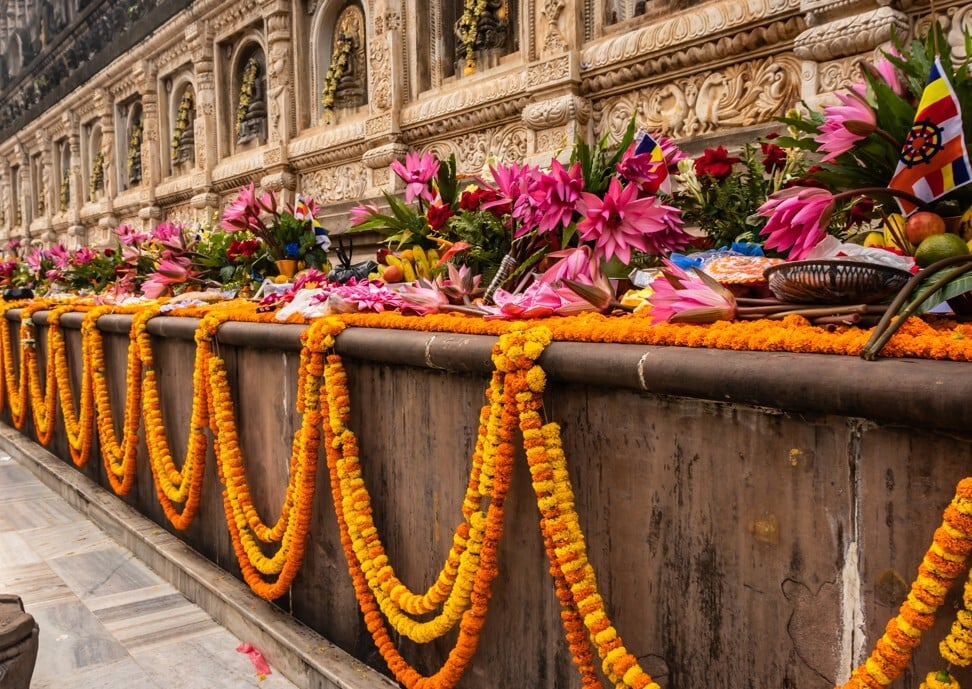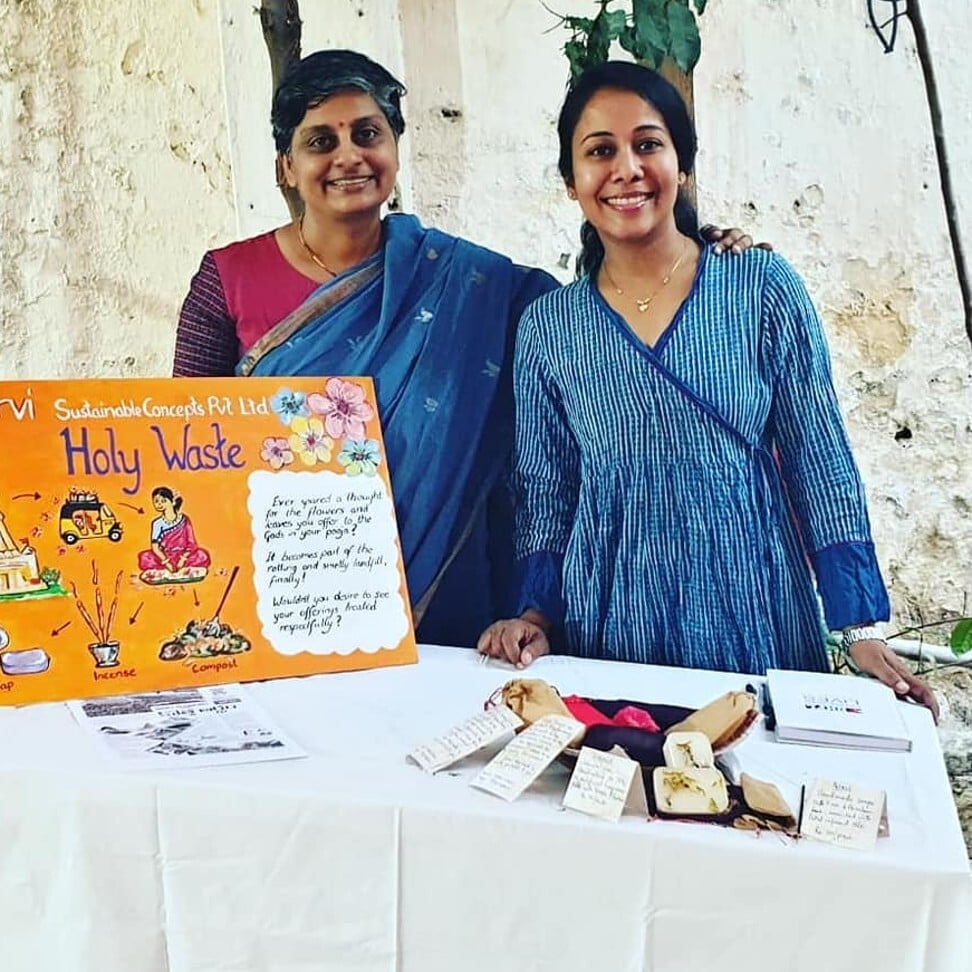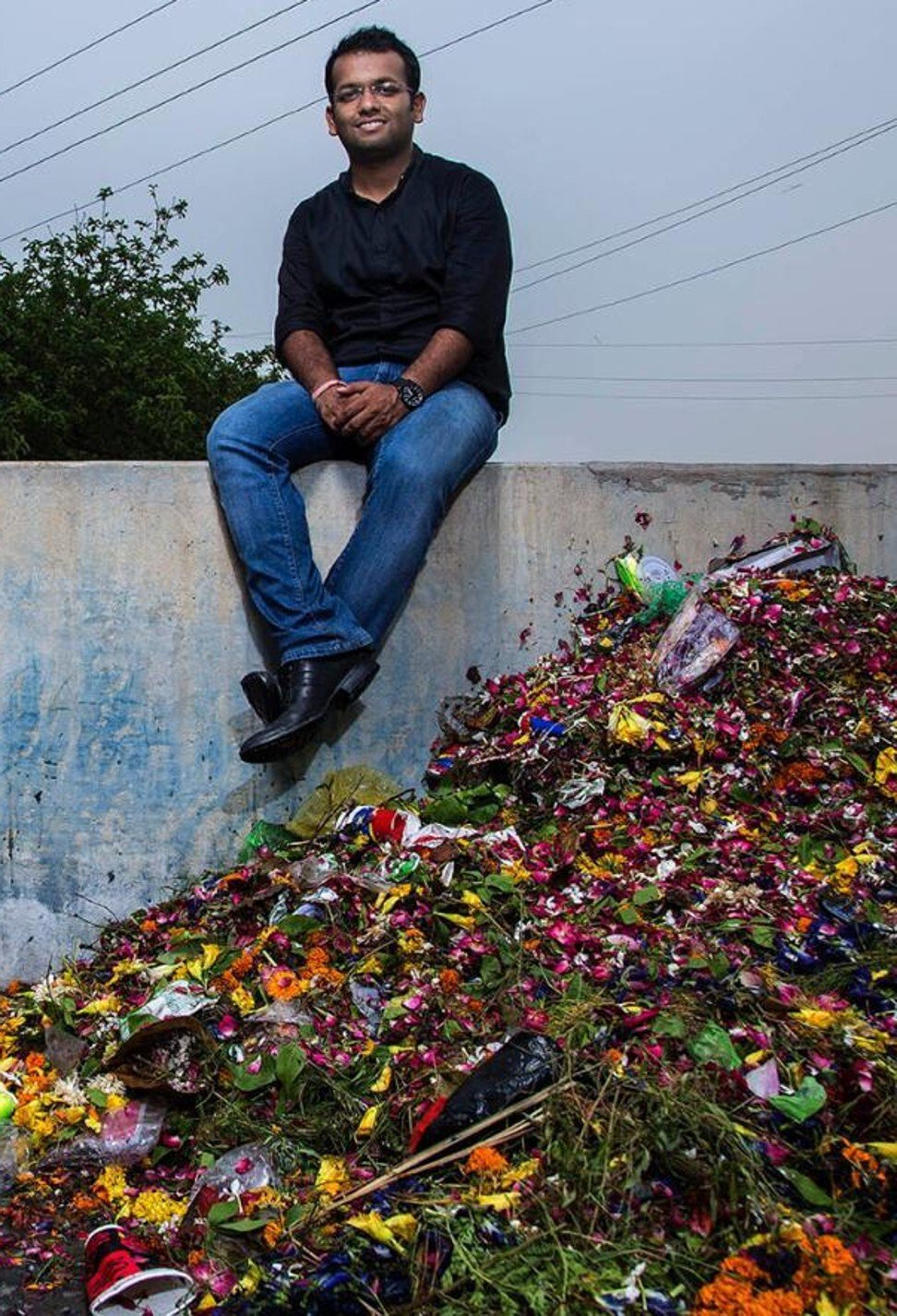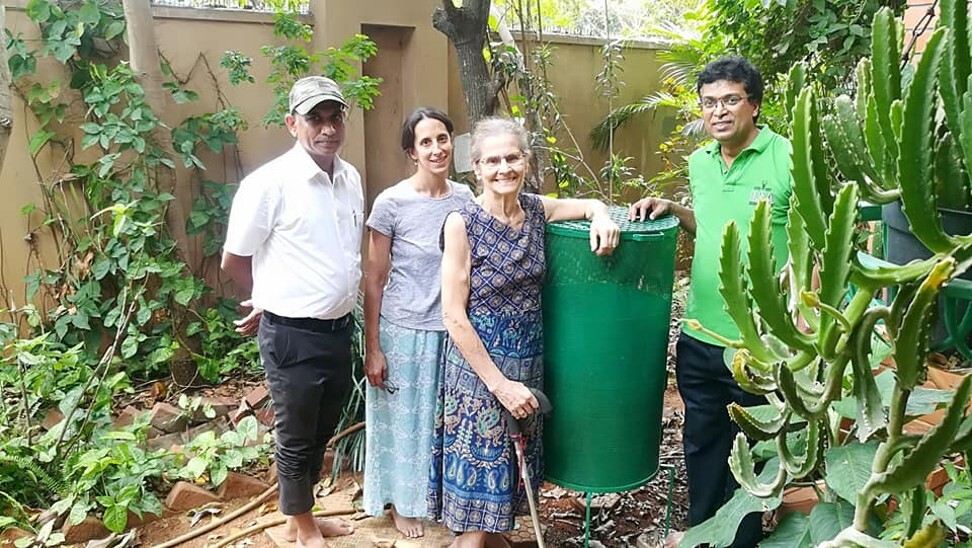
Recycling India’s floral waste: how flowers left as temple offerings are being made into soap, dyes and incense sticks
- Mountains of flowers are left as offerings at temples in India every day, and when they die they are often thrown into ponds and rivers, clogging them up
- Small companies have sprung up to recycle floral waste, using it to make incense sticks, dye, coloured powders and compost
Devotees hurry to buy flowers from vendors to fill their baskets and join the sea of women heading into the gaily lit and brightly decorated temple. It’s the evening of an auspicious festival and temples all over the southern Indian city of Hyderabad are crowded with Hindu worshippers, most bringing offerings of flowers: marigolds, lilies, roses and chrysanthemums.
The faithful leave the temples with blessings, but they leave behind piles of blossoms and leaves too.
Hyderabad homemaker Aruna Parvathaneni, 70, has spent much of her life worshipping in temples, and is well aware of the lifespan of floral offerings, from purchase to them being discarded.
“Usually the flowers are dumped near trees or in water bodies,” she says, although sometimes, during festivals, the blossoms are collected in large boxes and turned into compost.

According to research by Pradip Kumar Maity for the International Journal for Research in Applied Science & Engineering Technology, about eight million tonnes of floral waste is dumped into rivers and other bodies of water in India every year, choking and polluting them, and leading to environmental degradation.
Hyderabad-based entrepreneurs Maya Vivek, 43, and Minal Dalmia, 41, say the city’s lack of waste management for dead flowers paved the way for their niche start-up, Holy Waste. It is one of a number of small commercial enterprises in the country using the dead flowers, a long neglected resource, to make incense – instead of using charcoal and sawdust, or other ingredients – as well as soap, dyes, or coloured powders for Hindu religious festivals such as Holi.
In this Indian city, locals love K-pop and Koreans love Indian food
Floral waste is collected four times a week from 20 Holy Waste collection bins near a number of Hyderabad temples, trucked to the firm’s headquarters, and picked over by hand. The start-up produces handmade incense sticks, soap, compost and personalised gifts. Vivek and Dalmia’s primary aim is to convert the left-behind offerings into eco-friendly and child-safe products.
“Ten women are involved in packing the raw material and supplies. We pay the women for their work or buy back the finished product,” says Vivek. “We are planning on partnering with institutions for the specially-abled to make packaging material using recycled paper.”
The amount of floral waste produced in Hyderabad surges during India’s protracted festival and wedding seasons. Dumping it directly in landfills along with other waste such as plastic and construction debris means it takes longer for the green matter to degrade.

Without sufficient exposure to air, the waste can take up to 30 years to decompose, and in the process release harmful greenhouse gases including methane. With Hyderabad’s population growing, the city’s limited landfills are overflowing.
Thus Holy Waste is performing a service by removing some of the floral waste left at the city’s temples every day.
Dalmia says none of the flowers the company collects are thrown away. “The sepals and stems are kept apart and put into compost along with cow dung, which we later sell in the market,” she says. In two years, Holy Waste has diverted 200kg of floral waste daily from Hyderabad’s landfills and lakes.

Karan Rastogi, 32, a graduate of the University of Warwick in the UK, established Help Us Green in 2015 with the aim of making religious practices more sustainable.
Every day, Help Us Green collects more than 2.5 tonnes of floral waste from places of worship in and around the city of Kanpur in northern India, and has connected with the Smart City Mission of Kanpur to collect floral waste from high-rise buildings. This keeps the waste from polluting the holy Ganges River.
It converts the waste into organic fertiliser, aromatic sticks and coloured powders. “We have introduced zero-waste packaging,” Rastogi says. “There’s no plastic involved in packing the incense sticks; they are packed in biodegradable paper which is made from garment waste.”
Help Us Green trains underprivileged people to make aromatic sticks and incense, for which it pays them the legal minimum wage.

Another outfit using discarded temple flowers is the MATR (Motherly Luxury Artistry) foundation in the northern city of Gaya, in Bihar state. After seeing heaping mounds of dead blossoms thrown into the Phalgu River, MATR founder Praveen Chauhan, 35, joined an Australia-based sustainable clothing label, Because of Nature, run by Kathy Williams, 58, to start The Happy Hands Project and make use of the floral waste.
The flowers that are not used for dyes are made into coloured powders for religious celebrations.
“MATR is a social initiative that works with weavers, so we’re working towards a sustainable vision,” says Chauhan. “Dyeing khadi clothes with pigment from floral waste seemed the most natural thing to do.”

The company’s next objective is to reuse discarded flowers in the temple cities of Vrindavan and Mathura, home to many widowed women and huge generators of floral waste. The women use flowers in their daily prayers, religious songs and to celebrate Holi.
Williams looks after the marketing and Chauhan works at the grass-roots level, employing marginalised women to separate, dry and grind the flowers, and to dye the fabric.
The Central Institute of Medicinal and Aromatic Plants (CIMAP), a research institute in Lucknow in northern India, has been working in the floral waste field since 2008.
The institute has been producing incense sticks, cones and dhoop – short, thick aromatic sticks – using dead flowers collected from various temples, and offers popular temples technical help to convert their floral waste into useful products.

These temples, including the Vaishno Devi temple in Kashmir, the Ajmer Sharif Dargah in Ajmer, Rajasthan, and the Chandrika Devi temple in Lucknow, can draw enormous crowds, although the Covid-19 pandemic has interrupted worship.
“We also manufacture [beneficial extract] lutein from floral waste, which is a source of vitamin A,” says Ramesh Kumar Srivastava, 48, senior scientist at CIMAP. The institute trains women to make incense, and conducts workshops on how dead flowers can be used to make various products.
In Bangalore, in southern India, waste management executive Vasuki Iyengar, 51, runs awareness camps on his specialist subject, and the importance of segregating and composting. His venture, Soil and Health, has been managing waste since 2016 and he says it was initially difficult to change people’s minds.
“Temple committees were of the notion that composting on the premises would generate a foul smell or attract flies and insects,” Iyengar says. “But after seeing people successfully composting in their homes without any such problem, they followed suit.”

Soil and Health has installed more than 150 mesh or leaf composters near 25 temples and churches, 20 blocks of flats and five parks, to compost flower and leaf waste. Since becoming aware of the company’s success, many Bangalore temples have started composting waste on their premises.
The vast metropolis of Mumbai also has a flower waste organisation to help transform some of the dead and dying temple flowers into useful goods. In partnership with 15 temples, Green Wave, a Mumbai-based social enterprise founded by brothers Nikhil and Preetham Gampa, uses about 300kg of floral waste a day to make incense sticks. More than 50 women from the city’s slums are employed by the enterprise.
“I was on a field trip in Madhya Pradesh and ended up contracting malaria after sleeping in a temple because the nearby pond, filled with floral waste, was breeding mosquitoes,” says Nikhil Gampa.

“It prompted me to do something and I was happy that by replacing charcoal with floral waste, I don’t have to worry about harmful carbon emissions, and I was actually making a difference to the environment.”

